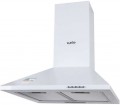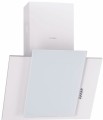Design
—
Dome. Hood with a round or rectangular air duct; in the lower part turning into a conical or trapezoidal body. Usually, it has a discreet design with a minimum number of decorative elements. Exceptions to this rule apply to
country style, shown separately.
—
T-shaped. Outwardly, it resembles a dome hood, but instead of a conical or trapezoidal body, the air duct ends with a flat rectangular air intake. In cross-section, the system resembles the letter "T" for which it got its name.
—
Angled. In such hoods, the air intake panel is installed at an angle to the duct. This design is purely aesthetic and does not affect functionality.
—
Vertical panel. A special type of wall-mounted hood that is as close as possible to angled models, except that when not in use, the front panel is parallel to the wall and not at an angle.
—
Cylindrical. Classic cylindrical hoods.
—
Rectangular. Hoods of an even geometric shape of a solid design and do not have a division into a duct and a body (as is done in T-shaped models).
—
With glass. The main distinguishing feature of all such hoods is the presence of a glass plate in the design as an additional decorative
...element. The very appearance of the hood can be anything: dome with glass, T-shaped with glass, angled with glass, cylindrical with glass.
— Visor. Extractor hood designed for installation under a kitchen cabinet. At the same time, the air duct is hidden inside, and outside there is only a flat air intake resembling a visor (hence the name). Glass is often used in the design of the visor.
— Sliding panel. As the name implies, these hoods are equipped with a retractable air intake panel. During operation, the panel opens — thus increasing the effective suction area. The hood itself is usually built into a cabinet or table (see "Product type"). But this type can be implemented in two ways. Sliding hoods with open panel when closed have a front panel that stands out and is visible under the cabinet. Sliding hoods with hidden panel are not visible when closed, and the opening mechanism is designed in such a way that the panel extends slightly at an angle.
— Fully built-in. Hoods that are built-in in the full sense of the word: the device is almost entirely hidden in a hanging cabinet or ceiling; only the air intake panel is outside. Such an installation is known by a minimum of visible details and allows you not to worry about how the hood will fit into the kitchen interior.
— Modern (unusual design). Hoods with a hi-tech look — using polished metal, glass and a minimum of decorative elements. Most modern style hoods have a specific design that does not fit into any of the options described above; Therefore, they are separated into a separate category. However, the design of such devices may vary; there are both absolutely minimalistic and rather pretentious, original design.
— Country. Country-style hoods usually have light, soft body colours (white, beige, light grey) and structural elements decorated in wood, bronze and other similar materials. By design, such devices are usually similar to domed ones. Note that with similar performance, country hoods are noticeably more expensive than conventional style models. In addition, they are quite demanding on the environment: the whole kitchen must be made in a similar style. otherwise, it is likely that the device simply does not fit into the interior.Motor power
The power of the hood at maximum speed.
The more powerful the device, the more performant it is, usually. However, there is no rigid dependence here, and hoods of the same power may differ in actual performance. So it is worth evaluating power consumption in terms of power first of all: the lower this indicator, the more economical the device. And when evaluating performance, you need to look not so much at power as at the directly claimed flow of the air (see below).
Max. noise level
The level of noise produced by the hood in the loudest mode of operation. Usually (but not necessarily) it is the maximum power mode. It affects the comfort during operation of the device, so
quiet hoods will be more preferable, but also more expensive.
The decibels in which the noise level is measured are non-linear units, so it is easiest to use comparison tables to estimate a specific value. Here is the simplest table for the values relevant in this case:
— 35 dB. The volume of a conversation in an undertone (but not a whisper). The lowest maximum noise value in modern hoods. Devices with such characteristics are almost guaranteed not to cause inconvenience: such noise is often blocked by other sounds, for example, the background noise of the street in an open window.
— 40 dB. The volume of a normal conversation. The maximum noise level allowed in a residential area during the day. If the hood is bought for home use, and it is supposed to be turned on often and for a long time, the noise level in the selected device shouldn't exceed this indicator.
— 50 dB. Conversation volume at medium tones.
— 60 dB. Raised conversation.
— 70 dB. Sound background on a busy street, in a crowd of people talking loudly, the sound of a vacuum cleaner motor at a distance of 2 – 3 m.
— 75 dB. Scream or loud laughter at a distance of about a metre.
— 78 – 79 dB. Loud mechanical alarm clock, motorcycle o
...r truck engine. The highest level in modern consumer-grade hoods.
Note that the actual comfort of using the device depends not only on the volume but also on the timbre (tonality) of the noise: for example, a low, even rumble is generally perceived easier than high frequencies with clanging notes. If the hood installation is unsuccessful, the actual noise level may be higher than stated in the specifications. For example, additional noise can be caused by the hum of air in the ducts or rattling from the contact of the vibrating body with the wall. However, when choosing, it is worth focusing on the noise level claimed in the specifications.Grease filter
The type of grease filter normally used in the hood. Usually, it has the appearance of a fine mesh that traps drops of fat and kitchen fumes. The grease filter can be like this:
— Metal. In this case, different materials can be used; most often, the word "metal" means a filter made of a relatively inexpensive alloy, and aluminium and stainless steel are usually listed separately (see below for more details). Common features of metal mesh are strength, durability and reusability: it is enough to wash and dry a dirty filter, after which it is ready for use again.
— Aluminium.
Filters made of aluminium alloys are considered to be very durable, because this material is highly resistant to corrosion. However, such filters are noticeably more expensive than ordinary metal ones (see above).
—
Stainless steel. Mesh made of this material has all the advantages of the metal filters described above; they are very reliable and durable, but at the same time not cheap. As a result, the use of stainless steel is typical mainly for premium hoods.
— Acrylic. A polymeric material similar to plastic. The main and the only advantage of acrylic filters is their low cost. At the same time, their service life is much shorter than that of metal ones. And some of these filters are generally disposable and cannot be cleaned after clogging. As a result, such filters are used mainly in low
...-cost models of hoods, and even then quite rarely.Slot suction
In hoods with a slot suction, the filter elements are hidden under a decorative cover. Along the perimeter of its fit,
gaps are formed through which air and other fumes are drawn in. The slotted design of the air intake increases the productivity of the hood while maintaining moderate power consumption.
Height (min)
The minimum height of the entire hood structure is from the lower edge to the upper part of the body (the point of connection of the external air duct). This parameter is indicated only for hoods with an adjustable design that allows you to change the height. Pay special attention to the minimum height if the device is planned to be installed in a kitchen with a low ceiling. In this case, it should be assumed that the optimal height of the air intake above the hob is 60-80 cm, and between the hood body and the ceiling, a headroom is required for the air duct. With a low ceiling, a hood that is too large may simply not fit into your kitchen.
Height (max)
The height of the entire hood structure is from the lower edge to the upper part of the body (the point of connection of the external air duct). For hoods with an adjustable design that allows you to change the height of the case, the maximum height is the size of the device in the unfolded state; in the case of non-adjustable hoods, this means a correspondingly constant overall height. When choosing a hood in height, it is worth proceeding from two points:
1. The optimal height of the air intake above the hob is 60-80 cm. This height allows the hood to capture kitchen fumes effectively and, at the same time, gives enough space to work with the hob.
2. Between the hood body and the ceiling, a clearance is required for connecting an external air duct.
Country of origin
The country in which this or that model is manufactured. Even though most of the capacities are concentrated in China, European factories for the production of household appliances have not disappeared. And certain models can be produced at them. In general, such a division into a Chinese or European factory should not particularly affect the quality of products, but the stereotype of a reliable European assembly is still present. However, it is possible that the model may have a country of manufacture, for example, Poland, and in the store under the same article, you will meet China.

